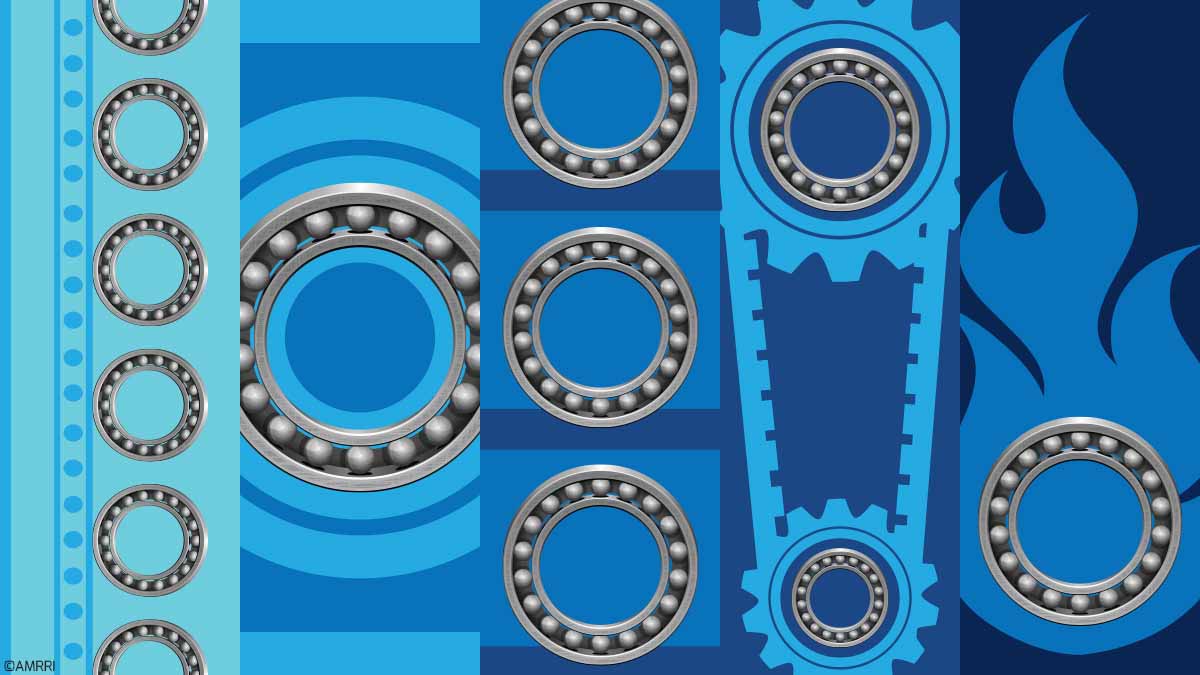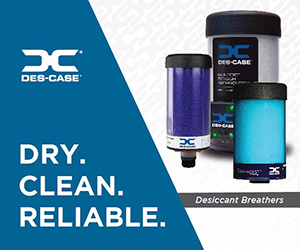All bearings are destined to fail eventually. While ineffective lubrication practices are arguably the greatest contributing factor in such failures, the root cause(s) are rarely investigated due to production and maintenance turnaround demands.
It’s through understanding the bearing lifecycle and associated built-in and application failures that maintenance and planning groups are able to develop effective premature-failure strategies.
As a bearing transitions from the drawing board to its final intended working environment, many elements can affect it. Design, storage, installation, and setup play essential roles in a bearing’s early life.
However, effective lubrication throughout a bearing’s working life will significantly impact the component’s longevity, performance, and equipment uptime.
Awareness of a bearing’s needs throughout its life stages will determine maintainability requirements and assure maximized reliability. The following overview of these five stages highlights influences and elements that can affect the reliability of your bearings.
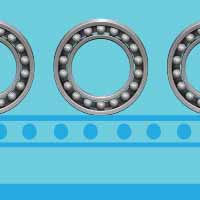 Stage 1: Manufacture
Stage 1: Manufacture
Reputable bearings are manufactured to the highest tolerances, assembled, and packaged in a contamination-free, environmentally-controlled process, often called “white Room” manufacturing. This ensures that the bearing leaves the factory as contamination-free as possible.
The first step to ensuring a long lifecycle for ball bearings is to only specify and use precision bearings. Precision bearings are easily identified by their ABEC (Annular Bearing Engineering Rating) classification rating, which ranges from ABEC 1 to ABEC 9. The higher the rating, the closer the bearing tolerance, making it more accurate and efficient.
The type of steel used to make the bearing will also affect its lifecycle. All rolling-element bearings are assigned an L10 rating that states their expected reliability in service. If the bearing has an L10a rating, the service life will be longer than a normal L10 bearing due to the use of a cleaner type of steel manufactured in an electric arc furnace.
Before packaging for distribution and sale, bearings can be pre-lubricated with a light assembly lube, a standard bearing grease or oil, or with a customer-specified lubricant. If pre-lubed with grease, bearings will rarely be shipped with more than a 30% cavity fill.
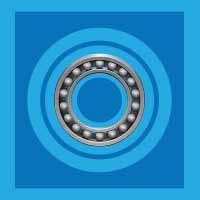 Stage 2: Application Design
Stage 2: Application Design
Original equipment manufacturers (OEMs) generally design machines in two different ways. Suppose the machine will be mass-produced and marketed to many other industries simultaneously. In that case, the OEM must base its design and bearing choices on a perceived set of generic operating conditions, i.e., load, temperature, speed, etc.
The second scenario is based on the end-user purchasing a “custom” designed and built machine. In this situation, the customer is in a better position to assure maximum bearing lifecycle, as the OEM can adjust the machine design and bearing choices to accurately accommodate a known set of operating and ambient conditions found in the machine’s intended workplace.
In turn, bearing type, style, and size can be more accurately engineered based on actual operating speed, design load, temperature, and working condition factors. These factors and the customer’s financial considerations determine which bearings will be oil or grease-lubricated.
At this point, the machine budget must be extended to accommodate centralized and automated lubrication systems. Compared to manual lubrication practices, these systems (when set up correctly) have been known to almost triple bearing life while reducing machine energy consumption.
The maintenance department must be included in machine-design-specification discussions during the application-design stage.
Maintenance can provide standardized lists of preferred lubrication-delivery systems (to reduce internal spares) and preferred lubricants, allowing bearings and reservoirs to be pre-filled and delivered with customer-standardized lubricant types and viscosity. This will reduce any chance of initial fill lubricant cross-contamination and could lessen the bearing lifecycle.
At this point, the maintenance department can also request that all bearings on the machine be tagged with a number and identified on an OEM schematic that locates and lists all lubricated bearings by type, style, bearing identification number, purchase lead time, and ABEC rating. This will go a long way in facilitating regular maintenance in service.
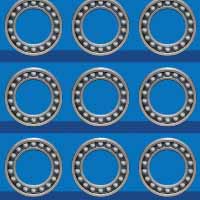 Stage 3: Inventory Storage & Handling
Stage 3: Inventory Storage & Handling
When bearings eventually reach their end-of-life, they will require replacement. Most maintenance-planning departments will already have a bearing-replacement strategy in place.
This usually includes ad-hoc purchases from third-party suppliers, when needed, or purchases and in-house inventory stocking bearings, especially those with long lead times. If the second option is chosen, the maintenance department will require a storage strategy to ensure that the bearings are opened and used as if just received fresh from the factory.
New bearings must always be handled carefully, stored in their original packaging materials, in a vibration-free cabinet (to eliminate false brinelling and flat spotting on running surfaces), and housed in a clean, humidity-controlled environment. (Bearings can rust in humid environments.)
Keep in mind that if personnel leave bearings unwrapped, touch their surfaces with bare skin, spin them by hand or with compressed air, drop them on the floor or bench, or expose them to moisture and poor air quality, these components can deteriorate before first-time use and suffer a premature failure.
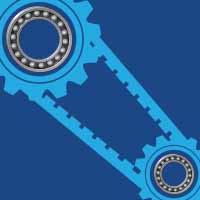 Stage 4: Installation, Machine Setup
Stage 4: Installation, Machine Setup
During bearing installation, reaching and surpassing the expected L10/L10a service life will rely on the precision-maintenance skill and knowledge of the tradesperson to correctly install and align the component in place.
Forcing bearings into place using blunt-strike tools can cause immediate surface brinelling. Bearings that fit too loose or tight can cause surface scoring, rapid wear, and fatigue failure.
When bearings are employed in belt and chain-drive systems, accurate motor, pulley, and gear alignment are essential for their survival. Both angular and offset misalignment will excessively and unevenly load a bearing, causing wide ball-path wear on the inner race and non-parallel wear on the outer race, leading to premature failure.
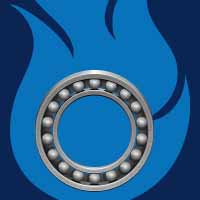 Stage 5: Service-Life Maintenance
Stage 5: Service-Life Maintenance
Once a bearing has successfully been placed in service, the operating conditions and quality of the lubrication-management program will influence its lifecycle.
For example, a standard 6206 bearing employed in the white-room-controlled environment of a pharmaceutical manufacturing plant is likely to survive significantly longer than its counterpart used in a foundry that requires high process heat and sand (silica) to turn out products.
The end user’s manufacturing process dictates working conditions. Of course, it’s hoped that the design will have been optimized to ensure long machine and bearing life. Whereas a pharma plant presents ideal conditions for bearing life, a foundry presents less-than-perfect conditions, which must be compensated for.
Based on the Arrhenius Rule, cool-running bearings live longer than hot-running ones. A temperature-change-dependent failure rate for materials and fluids operating above 176 F (80 C) will apply.
The Arrhenius Rule shows that “for every 18 F-deg. (10 C-deg.) increase in temperature, the lubricant lifecycle (and bearing protection) will be reduced by half.” Fortunately, the reverse is true: By reducing the lubricant-operating temperature, we can expect to double the lubricant life and gain a correlative increase in the bearing lifecycle.
Note that when bearings are subjected to localized high heat, they can be cooled inexpensively by placing a heat sink/cover between the bearing and the heat source. (A simple aluminum- pie-plate heat sink can reduce the temperature by 3 to 5 degrees.) Bearing covers can also protect against water, sand, and dirt, all detrimental to bearing life.
Whatever stages of life a site’s bearings are in, the maintenance and planning group will perform a vital role. A thorough understanding of a bearing’s lifecycle can help extend it and, in the process, capture a host of benefits for the operation.
This article was originally published in The Ram Review.



